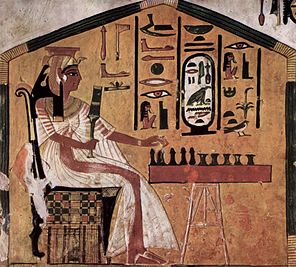Senet

|
| Senet in hieroglyphs | ||||
|---|---|---|---|---|
Senet (Sn.t, "passage/gateway") |
||||
| Painting in tomb of Egyptian Queen Nefertari (1295–1255 BC) | ||||
Senet (or Senat) is a board game from ancient Egypt. The oldest hieroglyph resembling a senet game dates to around 3100 BC. The full name of the game in Egyptian is thought to have been zn.t n.t ḥˁb, meaning the "game of passing".
Senet is one of the oldest known board games. Fragmentary boards that could be senet have been found in First Dynasty burials in Egypt, c. 3100 BC. A hieroglyph resembling a senet board appears in the tomb of Merknera (3300–2700 BC). The first unequivocal painting of this ancient game is from the Third Dynasty tomb of Hesy (c. 2686–2613 BC). People are depicted playing senet in a painting in the tomb of Rashepes, as well as from other tombs of the Fifth and Sixth Dynasties (c. 2500 BC). The oldest intact senet boards date to the Middle Kingdom, but graffiti on Fifth and Sixth Dynasty monuments could date as early as the Old Kingdom.
At least by the time of the New Kingdom in Egypt (1550–1077 BC), senet was conceived as a representation of the journey of the ka to the afterlife. This connection is made in the Great Game Text, which appears in a number of papyri, as well as the appearance of markings of religious significance on senet boards themselves. The game is also referred to in Chapter XVII of the Book of the Dead.
Senet also was played by people in neighboring cultures, and it probably came to those places through trade relationships between Egyptians and local peoples. It has been found in the Levant at sites such as Arad and Byblos, as well as in Cyprus. Because of the local practice of making games out of stone, there are more senet games that have been found in Cyprus than have been found in Egypt.
...
Wikipedia

